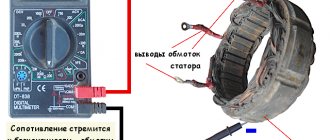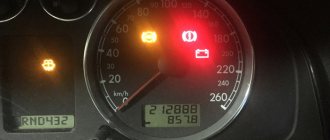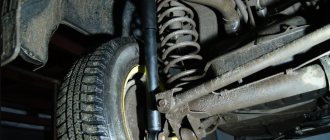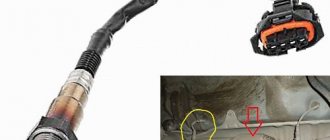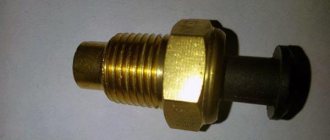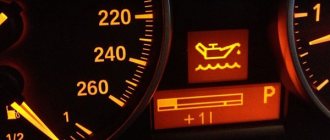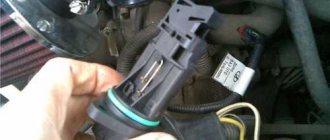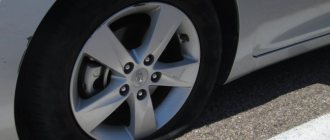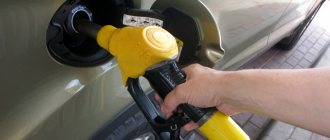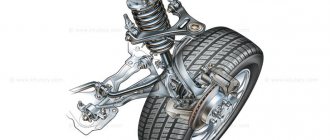A spare wheel and a full-size spare wheel - what's the difference?
Instead of a full-fledged spare wheel of a car, a tire holder takes up less space in the trunk or in the cabin, and helps you get to the nearest service center without outside help if a tire gets punctured on the road. From the name it is clear that it is used in critical situations and “rolled” on it to the repair site.
On a tire, you can drive from 60 to 200 km, depending on the model, without exceeding a speed of 80 km/h. Most brands that equip new cars not with a full-fledged spare tire, but with an additional one, for example, BMW X1, X7, recommend not driving faster than 60 km/h.
The popularity of dokatok is explained by two factors:
- Lower cost.
- Minimum space taken up in the trunk.
It is easier to install a tire on a car due to its light weight, but when replacing wheels, it is necessary to take into account the specific features of the vehicle, first of all, the type of drive.
The first emergency wheel appeared at the same time as a full-size spare wheel, but it has been actively used for the last 10 years. The addition of a re-roller reduces the cost of a new machine - this is the main factor that manufacturers use when equipping single-wheel drive models with it.
The rolling wheel differs from the standard wheel in technical characteristics, weight and size. When choosing a spare wheel, it is recommended first of all to pay attention to the standard sizes - the size of the tire can be no more than 1 inch smaller than the standard tire. If the car is equipped with R15 size tires, then it is necessary to select a tire size with a rim diameter of at least 14 inches.
How does a rolling wheel differ from a standard wheel?
The difference between a re-roller and a full-fledged spare tire is also visible in the materials of manufacture. Standard wheels are made of high-strength steel or aluminum; for emergency wheels, ordinary industrial steel of minimal thickness is used. The emergency wheel tread has a maximum service life of 2,000 km.
Since the contact area of the tire tread is much smaller than that of the standard one, it is necessary to monitor the pressure level in the emergency tire. Experts recommend keeping the pressure in the dock at 4.0-4.2 atmospheres. In some cases, it is possible to increase the pressure to 5 atm.
For example, the characteristics of the tire on the Nissan X-Trail:
- diameter - 17 inches;
- disk – stamped;
- profile width – 155 mm, height – 90%:
- rim width – 40 mm.
For this crossover, you can drive up to 200 km without stopping.
How to make a document for a VAZ: fines
Even though the VAZ car rental is cheap, not everyone wants to spend money. Many people prefer to make the resurfacing wheel themselves. A do-it-yourself VAZ wheel can be made from a VAZ 2106 wheel (5×13 ET29) with a 135/80 tire. The disc should be painted in a bright color. The homemade dokatka is ready. The diameter of the mounting hole is 4 mm larger, but you can get to the tire shop at the right speed.
You might be interested in this About inflating car tires
A spare tire can be an excellent solution for many owners of small cars that do not allow the possibility of transporting a standard spare tire. The advantages include:
Zhigulevsky variant
- Small sizes, which guarantees that they take up less space in the trunk. When traveling, it is possible to take with you several travel documents that will fit in the car.
- Low price. Due to cheap materials and availability, creating a dokatka will cost the driver several times less.
- In the event of a tire puncture, it is easier to restore it. Easier to disassemble and assemble.
- It is easier to change since it is light weight. This moment reduces gasoline consumption.
Note!
We must not forget about fines. There will be no penalty for driving on a tire if the puncture occurs while driving and the driver is sent to a tire repair shop. Operating the machine while rolling is permanently prohibited - a fine of 500 rubles*.
Features of control and movement on the emergency wheel
Even if the original dokatka is installed, the nature of driving the car changes, the electronic control unit, differentials, etc. begin to work differently. What the driver needs to remember:
- The braking distance increases by 120% due to the reduced contact area of the tire tread with the road.
- If the difference in angular speeds increases on the axis where the emergency wheel is installed, there is a danger of damaging the differential.
- Stabilization systems (ESC) must be turned off if the size of the tire wheel is critically small and differs from the standard wheel size by more than 1 inch. The system may malfunction and incorrectly redistribute torque to the wheels due to the fact that a smaller disc diameter may be recorded as slipping.
What happens if you drive on overinflated and flat tires?
Any measured parameter in automotive technology has a certain tolerance of values around the nominal value. No more and no less. When the boundaries of this range are exceeded, the operation of the nodes is disrupted, which entails undesirable and even dangerous consequences.
On topic: How to unscrew the lock on a wheel if you lost the key
The tire is entirely responsible for contact with the road; there are no other ways to keep the car on its trajectory. A civilian car does not have controlled aerodynamic surfaces such as wings or elevators.
Therefore, it is important to ensure the normal operation of the tread patch. In addition, its change greatly affects the service life of not only the tire, but even the disk and suspension elements.
Driving with reduced pressure leads to a number of deviations:
- tire service life decreases due to cyclic abnormal deformation of the sidewalls with wheel rotation speed;
- the wheel overheats, which consumes fuel energy and increases consumption;
- there is a high risk of wheel beading, that is, the tire suddenly falling off the rim followed by explosive depressurization;
- the tread wears unevenly and quickly;
- the car is poorly controlled due to increased lateral slip angles in corners;
- the increase in the area of the contact patch occurs in proportion to the decrease in pressure, which increases maneuverability on soft soils, but does not allow one to effectively overcome the layer of water and dirt on hard surfaces, and the danger of aquaplaning increases;
- the likelihood of a puncture increases.
But there is little good in high blood pressure:
- the contact patch decreases, the limit of adhesion properties with any coating decreases;
- the tread wears unevenly across the cross section;
- fuel consumption is reduced and rolling speed is improved, but at the same time the car’s braking capabilities decrease;
- The slip angles increase again, but this time due to increased wheel slip;
- the harsh operation of the pneumatics overloads the wheel bearings and suspension, increasing the vibration load of the vehicle as a whole;
- The tire may be damaged when hitting a large obstacle at high speed.
Particularly dangerous is unevenness in the pressure settings of tires on one axle and on different ones. Under certain conditions, the car can suddenly lose stability on its trajectory and go into an uncontrolled rotation.
How to install a dokatka on a car depending on the type of drive
Manufacturers recommend not installing a spare wheel on the drive axle. If the front tire in a front-wheel drive car is punctured, it is recommended to carry out a full replacement: remove the rear wheel, move it to the front axle, and install a tire at the rear.
What is special about riding a dokatka?
Many drivers neglect this procedure, since it is quite difficult to remove two wheels from the car on the road.
If the car has a drive on the rear axle, it is necessary to install the wheel on the front axle. This will minimize the load on the differential, but will significantly reduce handling. The speed with this installation should not exceed 50-60 km/h.
Rules for using the emergency wheel:
- When entering a turn, it is advisable to slow down as much as possible.
- When driving, you should avoid sudden maneuvers; you should not suddenly slow down or pick up speed, as the car may skid.
- Experienced drivers advise not to disable electronic systems that will help newbies hold their car in a critical situation, despite their possible incorrect operation.
No matter how strange it may seem, driving a car with a rebuilt vehicle requires the driver to have the appropriate experience.
What kind of spare tire should you have in winter?
It is recommended to install a summer spare tire
to the rear axle. Then, when braking, the torque will practically not appear. But there will be a risk of stern drift.
Interesting materials:
Which tile cutter should you choose, manual or electric? What density should I choose for attic insulation? Which printer is better for your home? Which profile to choose for drywall? Which profile to choose for PVC windows? Which profile to choose for the greenhouse? Which provider to choose in Moscow? Which vacuum cleaner to choose for wool? Which vacuum cleaner to choose for cleaning animal hair? Which repeater to choose for your dacha?
Is it possible to ride on a tire?
The traffic rules in this matter are clear: the tire tire is used only in an emergency, and you can only ride it to the place of repair - to a tire repair shop or to a garage.
It is not designed for speed and has distance restrictions. The fine for constant use of the dokatka is 500 rubles.
An emergency tire will allow you to quickly get out of a difficult situation and get to a repair shop, but only if the tire was punctured not during a long trip. You cannot use the tire all the time; before the trip, you need to properly inflate it and monitor the pressure level. And yet, a full-size spare tire remains the best option for replacement - it allows you to not lose either speed or control.
Source
The history of spare wheels
Spare wheels appeared on cars almost simultaneously with pneumatic tires. The first model equipped with a spare tire was the Rambler. This solution quickly caught on. The fact is that tire punctures on dirt roads strewn with horseshoe nails were a common occurrence. For a long time, the norm was to carry two or three spare tires.
During World War II, the production of cars equipped with a spare tire was prohibited in the United States due to a rubber shortage.
A dokatka will allow you to get to the nearest service station. Despite some advantages, it has many disadvantages. In many cases it is inferior to a standard spare wheel.
What is dokatka
A spare wheel that is the same size as the wheel of the main, working set, but has differences in tire width, is called an emergency wheel or “re-roller”. A standard attachment is included in most cars, has a distinctive color and is mounted in a special compartment in the trunk.
The purpose of such a spare tire is to independently drive to the nearest tire shop, garage or store in case of a puncture or damage to a car tire.
How long can you drive on a full-size spare?
Some automakers equip their models with full-size spare wheels, the same as the rest. Theoretically, you can ride it until it wears out completely. But in practice there is no need to do this, for the following reasons:
- Tread pattern may vary;
- the rubber composition is different, with worse characteristics;
- the number of layers in the tire is less.
Such a wheel not only initially has a bad effect on handling, but over time it will wear out faster than others, disturbing the balance more and more. Therefore, in the end you will have to buy new tires soon. And the accident is so close.
Important! Any spare tire is intended only to get to the nearest auto repair shop. Its long-term use is not intended!
Of course, if you took care in advance and installed a high-quality tire for the season, then there will be no problems. But few people do this.
What is the difference between a rolling wheel and a regular wheel?
The emergency wheel has a lightweight design, since it is used for emergency replacement of a damaged wheel of the main set in unfavorable conditions: on the highway, during rain or at low air temperatures.
Weight
The weight of the re-roller is significantly reduced compared to the weight of the main set wheel. The reason for this is:
- the stamped disk has a lightweight design and smaller width;
- nominal tire width is 1/3 smaller;
- The tire thickness is smaller due to a small layer of fabric cord and the height of the tread.
This design of the dock is designed to reduce the space occupied in the trunk of a car and increase ease of installation.
Standard sizes
The outer diameter of the emergency wheel must match the size of the wheels of the work kit.
How to choose a document
To choose the right tire for your car, you should focus on the following indicators:
- size – must completely match the size of the wheels of the main set;
- rubber quality - a dry and cracked tire will quickly fail;
- tread depth - the shallower it is, the worse the grip on the road.
The best tire is a wheel made for each specific car brand.
The emergency wheel is the best choice as a spare wheel. Having a low cost and good quality indicators, the dokatka takes up little space in the trunk and does not require special care. An important condition is that you must move to the nearest service station in compliance with safe traffic rules.
What pressure should be in the dock?
The operating or maximum permissible pressure in the tires of the main set and the emergency wheel is indicated in the vehicle operating instructions. In addition, such information can be printed on the pillar between the driver's side doors or on the side surface of the tire itself. The average value is 4.0 – 5.5 atm depending on the car model.
It is important to remember that the maximum possible pressure is 25% higher than the rated operating pressure.
Tire pressure table by car brand
The summary table of nominal pressure for a large number of cars contains factory recommendations in relation to the standard tire size.
When studying the table, you can find some patterns.
- The average value for high-profile tires ranges from 1.8 to 2.5 bar. This provides comfort, and in the case of higher values, some sportiness; the tire behaves better at speed.
- The low profile shifts the pressure range to 2.2-2.8 bar. Sometimes less, this is in the case of increased profile width. You have to find a compromise between comfort and controllability. But at low profile and pressure values, the likelihood of punching the rubber to the rim or becoming beaded after hitting bumps in a turn increases.
- Cars intended for transporting cargo have special cargo-type tires, which, despite their modest size, can withstand heavy loads, but the pressure must reach 4 bar or more. Especially the rear wheels under the loading platform with single tires. Here we are no longer talking about comfort, but about strength and reliability.
- Some tires are so modest in size that the pressure in them is increased, like low-profile and high-speed tires. Something in between with dokatki.
When inflating wheels, you should not give general instructions, such as “inflate the two,” but look at the sign on the body, often right in the filling hatch. This will ensure maximum safety, comfort and durability of the rubber.
On which axle can the dokatka be installed?
The general recommendations of emergency wheel manufacturers are that it is necessary to install the tire on a non-drive axle. However, there are some nuances:
- Four-wheel drive vehicle . Installing a temporary wheel on the rear axle only. If the front wheel is damaged, it is necessary to replace it with any wheel from the rear axle, and put a “dokatka” in its place.
- Front wheel drive car:
- Installing an emergency wheel on the front axle makes it difficult to start moving, increases the braking distance and reduces the vehicle's stability when cornering.
- The wheel on the rear axle does not affect the maneuverability of the car and has virtually no effect on braking.
- Rear wheel drive car:
- Rolling on the front axle does not affect the distribution of power flows, but can cause an increase in braking distance. It is recommended to enter a turn at a speed of no more than 20 km/h, especially in adverse weather conditions.
- A spare tire installed behind the rear axle has little effect on the braking process, but reduces the car’s maneuverability when cornering and requires attention when starting to move - you need to move away slowly, without jerking.
Thus, the optimal solution is to install a tire on the rear axle of the car. If this is not possible, it is necessary to strengthen control over the steering while driving.
74-70-69
A spare tire has been a necessary attribute of every car since its inception. Of course, this can be understood, because during the operation of a car, tire breakdown continues to be the most common problem. At the very beginning of the development of the automotive industry, drivers were forced to carry even two spare tires with them, but over time this trend has changed, so now there is only one spare tire in the car. Traffic rules state that every car must be equipped with all working wheels, including a spare one. This can only mean one thing: after replacing a punctured wheel with a spare wheel, in principle, you can move on until another wheel breaks and even ride until the tread pattern is worn down to the specified limit.
It is necessary to periodically change wheels, including the spare one, according to a specifically established scheme. It is generally accepted that only in such a situation are tires able to reach their maximum service life. It turns out that you can drive a lot with a spare tire, but still, it’s hardly worth it. If you use the spare tire as a working wheel for a long time, then the tread will inevitably change on it, so the wheel replacement scheme can no longer be considered as effective. It is preferable to go to the nearest service station and have the broken tire repaired there and put it back in place. Apparently, taking into account the good condition of roads in developed countries, many car manufacturers have decided that it has become unprofitable to carry full-length spare tires in cars due to their large size, which results in a lot of free space being taken away, so they began to produce so-called spare tires or emergency wheels. Unlike a full-length wheel, a rolling tire is a simplified version of it, as it has a much smaller width compared to a regular tire, but it has significantly higher air pressure. Such transformations did not bring anything good. Due to the reduction in the width of the tread on the wheel, the area of its contact with the road surface has also decreased significantly, and, given the increased air pressure, the risk of such a wheel being punctured by various foreign objects has increased significantly. These factors are especially relevant in our conditions, where sometimes you can find even more garbage on the roads than asphalt itself. But even if we talk about European roads, then when installing an emergency wheel, you will have to move at a speed no higher than 80 km/h, and here the point is not even in the existing risk of breakdown, but in the fact that with rolling back at higher speeds, the controllability of the vehicle is significantly reduced. In addition, there is evidence that due to the smaller diameter of the emergency wheel compared to the usual one, the differential begins to work incorrectly, which leads to malfunctions of the ESP, ABS and other safety systems. Driving on a trailer may lead to the need to call a tow truck to deliver the vehicle to a service center. That is why such a wheel is called an emergency wheel, that is, it is not suitable for normal driving and can only be used to get to the nearest car service center. The question of how long you can travel on a spare tire is rhetorical. But in any case, there is only one answer - you can go to the nearest tire repair shop.
At what speed can you go on a dock?
Since the dokatka is essentially an emergency wheel, the speed of the car should not exceed the 60 km/h established by the rules, despite the fact that manufacturers allow the use of such a wheel at speeds of up to 80 km/h.
It is important to remember that the maneuverability of a vehicle with a rollover is significantly reduced, so the speed limit should be chosen based on the driver’s experience and road conditions.
Features of choice
The question of how to choose a replacement tire for a car is usually asked by those car owners who want to save space in the spare tire compartment, as well as reduce fuel consumption due to the light weight of the donut. Experts say that when choosing a small spare tire, you need to focus, first of all, on its size.
When the tire is supplied by the car manufacturer along with the “iron horse”, it usually has the same diameter as other wheels. That is, when thinking about how to choose a replacement tire by size, car owners should focus on the size of their original wheels. In this case, a very small discrepancy in diameter is allowed, the value of which should not exceed 1 inch. For example, if a car is equipped with wheels of size R15, then a wheel with size R13 will no longer be suitable - its parameter must be represented at least R15.
How long can you ride on a dock?
If the diameter of the tire coincides with the diameter of the main wheels, then the distance that can be driven on it is 200 km in dry and warm weather, in winter - no more than 50 - 100 km.
If the size of the rolling wheel is larger or smaller than the other wheels (for example, the main wheels are 16 in diameter, and the rolling wheel is either 15 or 17), then the distance should be halved.
Why is there less documentation?
The tire rim is made of steel and is significantly smaller than the rim of a full-size tire. Accordingly, the width of the rubber put on the tire is much smaller. Please note: Most often, rolling is a budget solution, since such a wheel is not expected to be used for a long time.
Interesting materials:
How to remove a hidden number on Moldcel? How to remove a hidden Tinkoff account? How to remove the sweetness of tomato paste? How to remove slime from carpet? How to remove Slime from a cat's fur? How to remove Slime from hair at home? How to remove sticker marks from metal? How to remove sticker marks? How to remove cigarette marks on a coat? How to remove tape marks on clothes?
Rules for riding a dock
The main nuances when driving a car with a tire are as follows:
- due to the smaller wheel width, the contact area of the tire with the road surface is reduced, which leads to an increase in braking distance;
- the coefficient of adhesion of the tire to the road is reduced due to the shallow depth of the tread pattern, which threatens to impair the maneuverability of the vehicle;
- In power flows transmitted from the engine to wheels of the same axle, which have different masses, the relationship between angular velocities is disrupted, which leads to losses in efficiency and possible slipping on the road.
Since a tire puncture and installation of a spare tire is an emergency, taking into account all the nuances, when driving such a car you must adhere to the following rules:
- If possible, do not place a spare tire on the drive axle;
- do not use a wheel with low tire pressure;
- install an emergency wheel equal in outer diameter;
- disable electronic wheel locking systems when installing a wheel that has different outer diameters;
- do not exceed speed;
- move away smoothly, avoid sudden pressure on the gas pedal;
- reduce speed on turns to 20 - 40 km/h;
- The rotation of the steering wheel should be smooth and avoid jerking;
- Braking should begin in advance, avoiding sudden pressure on the pedal.
It is important to remember that the braking distance of a car with a spare wheel is always increased, regardless of weather conditions.
Why is there a tire in a car and not a regular wheel?
A spare wheel, or even two at once, used to be an indispensable attribute of the appearance of brutal vehicles of the first half of the 20th century.
Roads, as we understand them today, almost did not exist, so blowing a tire was a completely common occurrence. And they themselves were not particularly reliable. At the same time, tire shops were a rare exotic thing.
This is interesting: 5 reasons why the brakes squeak when braking
The first stage of departure from traditional automobile values of the beginning of the century was attempts to hide the spare tire somewhere, so as not to greatly distort the fast appearance of the car.
There were unexpectedly many such places:
- just put it in the trunk;
- provide a separate compartment in the trunk to protect things from dirty wheels;
- place the spare tire under the car, in its native environment of mud and splashes;
- hide it in a decorative cap installed on the side of the car or on the trunk lid;
- It was completely unexpected to provide space under the hood; many did not immediately like this solution, but, for example, the domestic Niva still uses it.
All these methods gave the designers the idea that spending so much space on storing a rarely used item is irrational. Space for passengers and cargo is priceless in terms of a car's competitiveness.
The frontal solution is to reduce the size of the spare tire or abandon it altogether. The last radical approach was postponed for the future, that is, now it is already the present, but they acted decisively with the size. The spare tire has become much more compact and has turned into what is now known as a spare tire.
Differences
Anyone can recognize a defective spare tire from the outside.
The difference is striking:
- the re-roll is noticeably smaller in terms of the width of the tire profile, its height, and in most cases, the outer diameter;
- the wheel disc is made of stamped steel, painted without pretensions to decorativeness, and is provided with bright color markings;
- the size of the disk is unusual, as a rule, it has a large offset, since it must replace a full-fledged wheel, and a narrow seat for a tire of a very modest size, more like a motorcycle;
- The wheel is quite light, which helps to remove and install it, but does not inspire confidence in its strength.
And not in vain, since the dokatka also has a lot of hidden differences:
- such a spare wheel is cheaper due to its primitiveness and limited possibilities for use;
- the quality of the tire leaves much to be desired, it is not intended for long trips;
- rolling is uncomfortable; due to its small size, the pressure in it is approximately twice as high as that of a full-fledged wheel;
- strength is also limited, there is no task here to overcome all the hardships of the roads, you just need to make it to the workshop;
- Few people balance a dokatka, since the speed of movement on it is very limited, vibrations will not occur.
Differences appear even in a car that has been re-shod. Usually it falls strongly to the road at the corresponding angle of the body due to the difference in the outer diameter of the wheels.
Features of choice
The dokatka is usually included in the factory equipment of the car. However, not all. And not always satisfied with the size. And sometimes you have to buy a spare wheel to replace a broken one, which is not surprising given its size and strength.
When purchasing, you should be guided by the bolt pattern of the wheel disk first, otherwise it simply will not fit into place. It is also necessary to check the offset and shape of the disc; it may touch the brake elements.
Pros of dokatki
Using a tire as a spare tire has the following advantages:
- small size;
- low cost;
- simplicity and ease of installation;
- no need to periodically replace the spare wheel with the main wheels in order to ensure uniform wear.
As long as you comply with the speed limit and braking rules, driving a car with a rollover is absolutely safe and quite comfortable.
Advantages and disadvantages of dokatok
The advantage of a defective spare wheel is its low weight and dimensions. Everything else must be classified as shortcomings, sometimes very serious ones:
- limited speed of use, this has to be observed due to the disgusting handling of the car, which actually rides on three normal wheels;
- The effectiveness of the brakes is also reduced due to the insufficient grip properties of a narrow spare wheel, and even with a poor-quality tread;
- rapid wear of ersatz tires even under completely normal conditions;
- high pressure in the wheel reduces the comfort of the trip by zero;
- When choosing a wheel with an insufficient diameter, all electronic driver assistants, which take information from ABS sensors located on each wheel, begin to make mistakes.
- you have to monitor the pressure in the spare tire, which should be very high, usually about 4 atmospheres.
All this leads to the fact that some manufacturers consider tires to be evil and sell cars without spare wheels at all, limiting themselves to a repair kit, or even equipping cars with run-flat tires, which allow you to drive after a puncture no worse than on a tire.
A full wheel is offered as an option for those for whom peace of mind is more important than a few liters of trunk volume.
Disadvantages of dokatka
The disadvantages of using a dokatka are as follows:
- Wheel pressure, tire condition and tread height must be checked regularly;
- due to the reduced area of adhesion between the wheel and the road, the braking distance increases and the maneuverability of the vehicle at high speed deteriorates;
- There is a risk of damage to the spare tire when driving on rough roads at high speeds (over 60 km/h).
Failure of the ABS, ESP or DSTC electronic systems only occurs when installing a wheel of a smaller diameter, since the difference in size is perceived as slipping or slipping.
Basic rules for running in
Violating the rules for breaking in a car can lead to unforeseen consequences, but you can get a guarantee that the car will last a long time. To ensure everything goes smoothly, you need to follow the following rules:
- refuel the car with high-quality fuel;
- check tire pressure;
- do not allow the engine to idle for a long time;
- monitor the engine oil level, the presence of coolant and brake mixture;
- make sure that there is no lubricant leakage;
- the first thousand kilometers during the break-in period are performed at a speed of less than 90 km/h, and it is also not recommended to use 4-6 gears;
- smoothly and promptly switch to the appropriate lower or higher gear (the car’s operating instructions provide a table with the permissible speed for each gear);
- During the break-in period, engine speed for gasoline engines should not exceed 3,000 rpm, and for diesel engines this figure is from 1,200 rpm. up to 2,500 rpm;
- avoid heavy loads on the car (long driving downhill or towing a trailer or other vehicles);
- It is prohibited to practice an aggressive driving style involving emergency braking and sudden acceleration;
- It is advisable to carry out the running-in outside the rhythm of city traffic, on highways with high-quality and smooth surfaces.
